Hello, hello,
This summer is one that is going to go down in my own personal history. There’s plenty going on, including two house moves and a wedding. It is definitely keeping me busy but not too busy to have history on the brain!
Last week I talked about historical memory and the very small chance of any of us ‘making history’, if that is defined as our name being recorded. As I said then, inventing things is definitely one way that you’re unlikely to go down in history, no matter how important the invention. One of the reasons for this is that the whole idea of ‘invention’ is a bit of… well, an invention.
These days, we’ve got patent offices and the stereotype of the inventor - often a slightly chaotic character, usually male, with a house full of half-finished projects and an otherworldly expression. For most of the human past, though, invention has been more of a social than an individual affair.
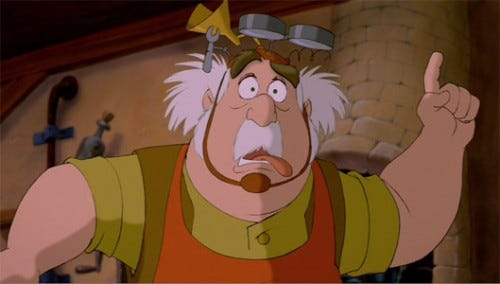
Even if one person invented something, which no doubt they did, all the time, the chances of it being recorded were almost zero until lots of people took it up and started using it. It might take generations for something to catch on enough for it to be pictured or written down enough times for one of those pictures or texts to survive centuries, and by then, probabloy nobody remembered whose bright idea it was. But then, people also probably didn’t think about it that way. One person might have an idea but it might take several people, all trying it out, tweaking and fiddling with it, to turn it into something successful enough for other communities to use. A good idea has never changed the world on its own: it needs to convince people to fund further development (especially if it is something complicated) or to use it in their own lives (if it is something fairly simple).
‘Invention’ as shorthand
Sometimes we do have historic tales of inventors or discoverers but they are often fictional: a character to give a human face to a bigger process. Romans believed that a man named Hippalus in the 1st century CE discovered how to travel from the Red Sea to South Asia using the monsoon winds. We now know the timing and techniques were already part of a wider social pool of knowledge by this time, but ‘Hippalus’, even if he wasn’t a real person, did mark a change. The 1st century was when travel using those monsoon winds increased. More people and more goods moved than ever had before. People in the Roman Empire became more aware, day to day, of products from ‘India’. The character of ‘Hippalus’ wasn’t an inventor or a discoverer. He was a personification of something bigger shifting in the world.
Inventions or discoveries weren’t single, lightbulb moments. They were processes of bigger change, often characterised by lots of people needing to solve the same problem at a similar time and coming up with overlapping solutions. As the old saying goes, ‘necessity is the mother of all invention’ and until a necessity a) existed and b) became widespread or c) acute enough, there was no reason to try to solve it.
A matter of money
One case study that illustrates this perfectly (and speaks to my interests) is the invention of coinage.
It happened in three regions of the world nearly simultaneosuly (at least within a century or so, which at this distnce, comes pretty close to being at the same time). In each region, it probably wasn’t invented by just one person. It was a response to a particular set of problems, which lots of people adopted and shared. Rather than asking (as people often have) who invented coinage, and when, we can get further asking what problems people faced and how coinage helped to solved them.
The period around 800-200 BCE was busy. The term ‘the Axial Age’ was suggested not by a historian but by a philosopher, Karl Jaspers, in the early 20th century. For him, this was a period in which big changes across lots of parts of the world caused human socities to turn, as if turning on a shared axle. Right across Afro-Eurasia, societies became more complex than before.
Complex, in this case, means that states got bigger. They built more, from palaces and cities to fortresses and monuments. The distance, socially, between the people in charge and the people who worked for them, grew larger, meaning that societies needed more people in between - managers, ministers, officials, overseers. Record-keeping became more common to manage all of this added complexity, and societies came into conflict with each other, opening up opportunities for mercenary soldiers, engineers and people who could set themselves up as diplomats and translators.
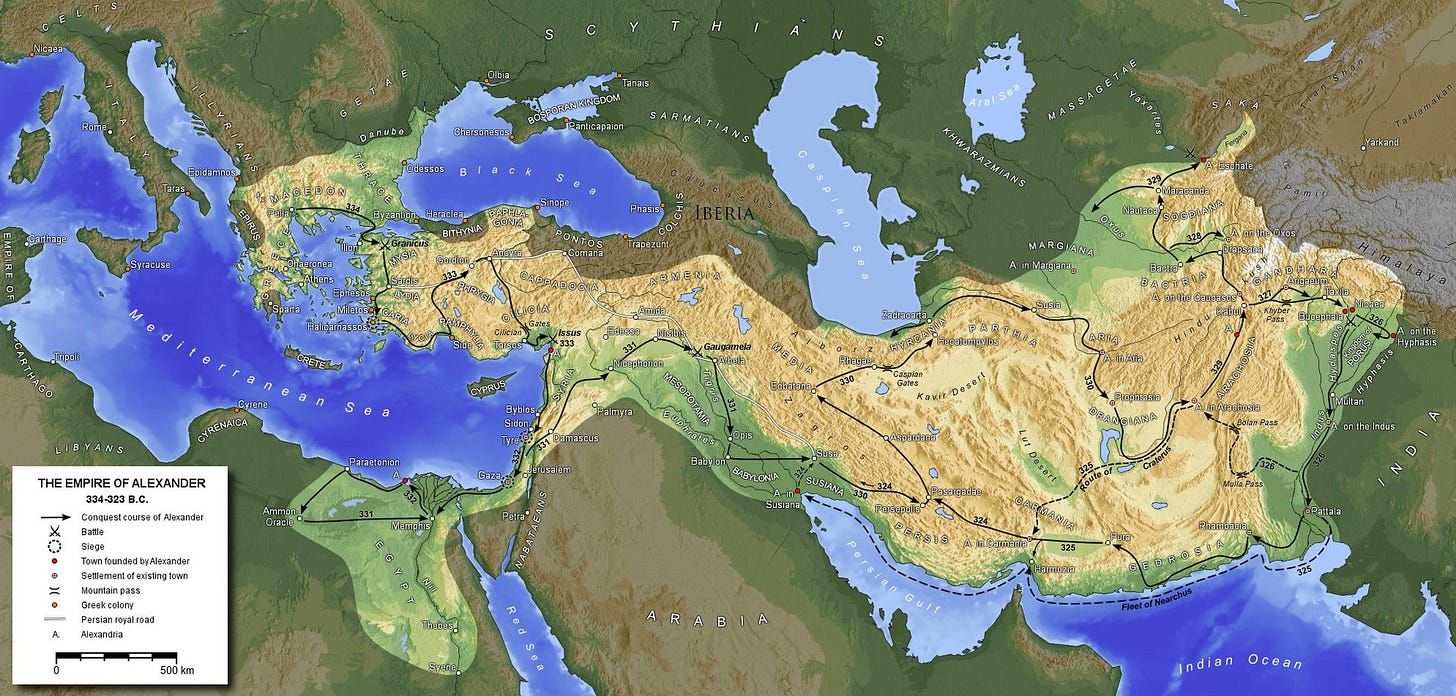
The figure perhaps most famously associated with this ‘Axial Age’ is Alexander III of Macedon (often known as ‘Alexander the Great’). He inherited a small-ish kingdom in the Aegean and spent the rest of his life (which wasn’t that long - he died in his 30s, probably as a result of a drunken swimming accident) conquering his way around the east Mediterranean and across Asia to the edges of the Himalaya. His later fame aside, the sheer disruption, mobility and cultural interaction Alexander created is, in many ways, typical of the Axial Age. All those people moving, meeting, fighting, sharing, combining cultures.
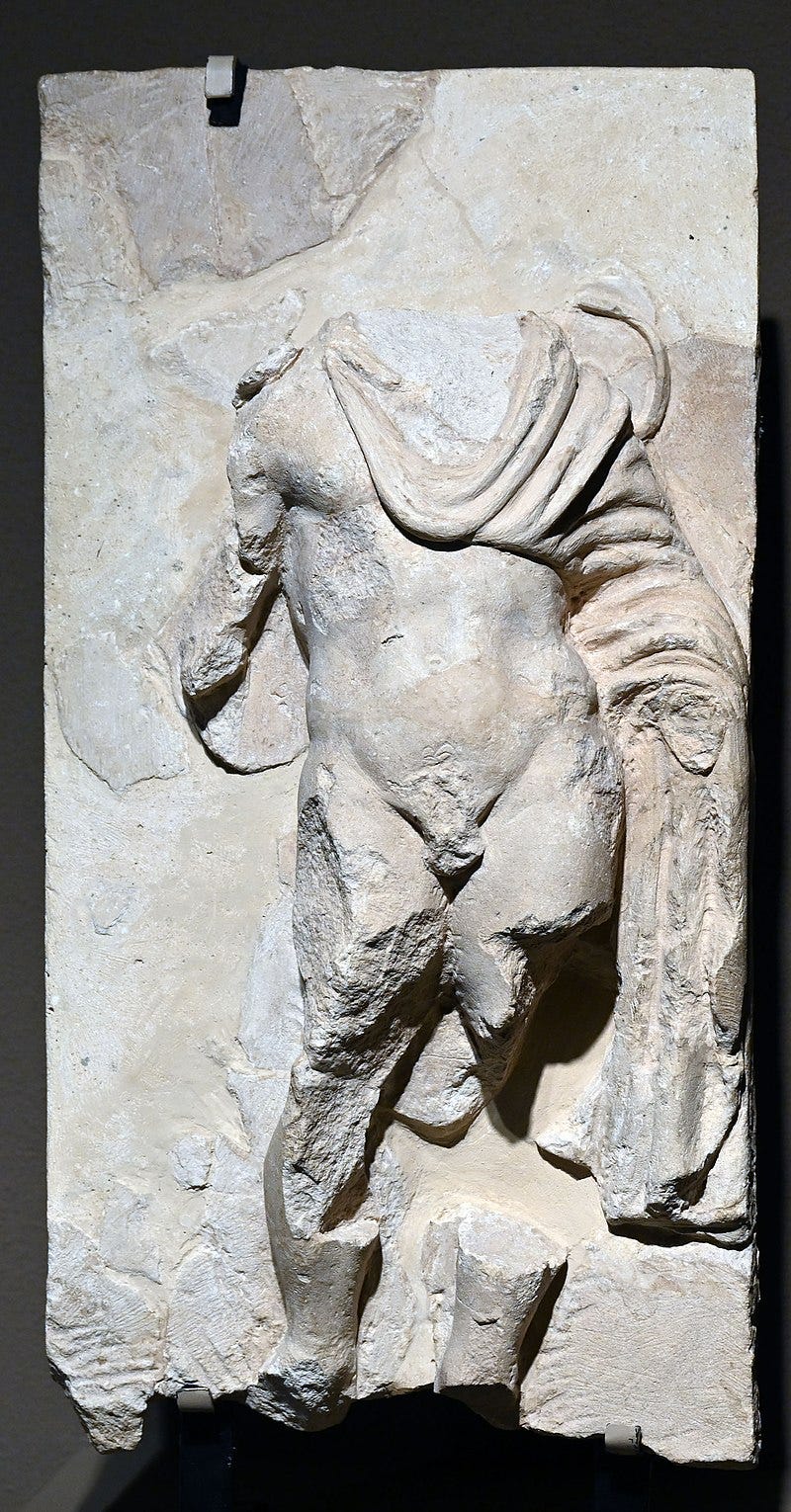
Most of the developments of the Axial Age were not ‘new inventions’. Most, such as written record-keeping or systems of managers and ministers, had already been developed in various places hundreds of years earlier, in what is usually described as the Afro-Eurasian Bronze Age (around 3500-1800 BCE). But, in the Axial Age, they spread and became more deeply embedded across more socieites.
One problem that all of this raised was anonymity. More people were doing more business with people they didn’t know, or possibly did know, but didn’t trust. From peasants paying their taxes to ever more distant states to mercenary soldiers blowing through and supplying themselves on the way, people in power and people without much power all had good reasons avoid relying on IOUs.
There are various theories for why coins emerged around this time and the answer is probably a bit of all of them:
that they were a way of managing increasingly complex credit arrangements;
or, the flip side of the same coin (pun intended), that they were a way of managing debts. In either case, coins could store value so that, for example, a farmer could be paid the future value of a crop that hadn’t yet finished growing (credit), or pay taxes on land they hadn’t yet farmed (debt);
or that they were a way of finalising a payment in one go, rather than having to wait (e.g. for crops to grow or land to be farmed) or to know anything about the other person, like what business they were in or what they might need or want.
An interesting feature of these earliest coins, though, was that in each region they appeared, people came up with slightly different solutions to these challenges.
Let there be cash
In East Asia, coins began as small models of tools and cowrie shells. In other words, people made little metal copies of things that were already valuable and tradeable, either because they took specialist skills and effort to make (such as metalwork like blades and spades) or because they were exotic (cowrie shells). These tiny objects started to carry notes stating that one little metal model shovel or blade was actually worth 5 or 10.
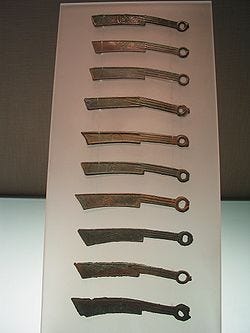
Eventually, models became simple discs with a declared value. Round shapes, with a square hole in the middle, could be cast in large numbers then the square hole used both ro knock casting sprues off the edges and to string them together into bigger units of value. What these coins were made of doesn’t seem to have been irrelevant but it wasn’t the thing that mainly determined their value. That was the value stamped on them.
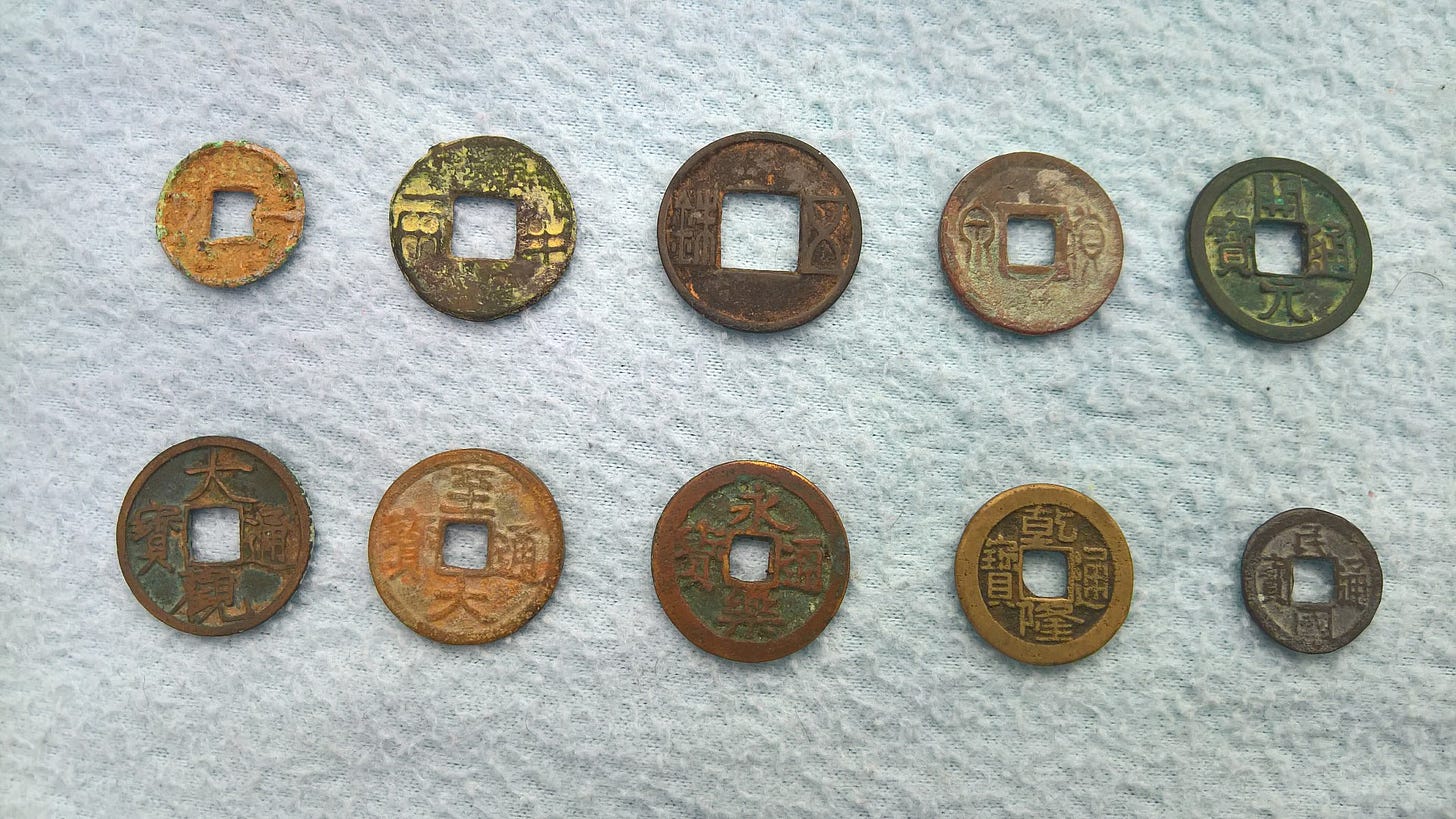
This system needed a strong authority that people would trust to guarantee the value of coins. The area around the Yellow and Yangtze rivers seemed to have that. With those round, stamped pieces of metal, people could do business with each other and rely on the value of the coins to be the same from one day to the next because the state and social convention said it was so.
Natural value
On the other side of Eurasia, on the shores of the Aegean, the same broad challenges generated a different solution. This relied on the idea that some things in the world are just naturally valuable and, indeed, have a stable natural value. Gold and silver were obvious candidates. They come out of the earth shiny, they don’t corrupt over time (or at least, gold doesn’t, and silver won’t if it is worn or polished). They are quite soft and easy to shape. And they can often be found, in areas where both occur naturally, in somewhat stable ratios.
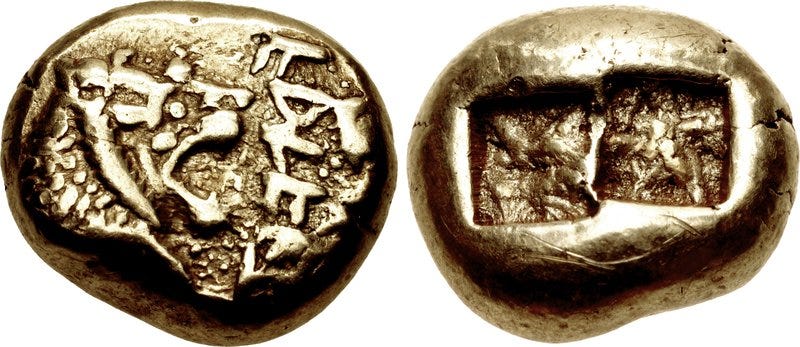
All of this was enough for ancient philosophers, all the way back to Plato, to argue that nature had provided a means of payment that all humans could agree upon. This was important, Plato argued, because it meant that people could easily work out the value of things and could do business with one another without needing to rely on trust. The idea that gold and silver had a fixed, stable value across time and space and in relation to one another has been persistent in West Asia ever since. It passed into Roman and then into Islamic law and gold, especially, retains a special status that means the British mint still issues special coin series in gold.
The state’s stamp on gold and silver coins in this system wasn’t intended to tell people how much each coin was worth. That depended (at least in theory) on the ‘natural’ value of the gold and silver. Instead, the state stamp was meant to show that the gold or silver in the coin hadn’t been tampered with, or adulterated with other metals. Lower value metals, like copper alloy, could also be used to represent subdivisions of silver and gold coins. And all of them would have a design hammered into them, roughly the size of the coin itself.
The very earliest examples of these coins were actually made of a mixture of gold and silver, called electrum, that is found naturally around the Aegean. Later, gold and silver were purified to create different denominations. A slightly later king of Lydia than Alyattes, who struck the coin above, was Croesus, and his coins, perhaps the first to be struck in solid gold, are probably connected with the legend of Croesus turning everything he touched to gold and to the phrase ‘as rich as Croesus’.
Crowd-sourcing silver?
The third solution to the problems of the Axial Age is the hardest to understand because it is the least clearly documented. But the circumstances on the ground in northern South Asia, around the rivers Ganges and Indus, were very similar. More and larger and complex states were developing. People were moving longer distances, especially as part of armies. More things were traded between regions. Exactly how the system worked is still a bit of a mystery but we can try to work our way back from what remains.
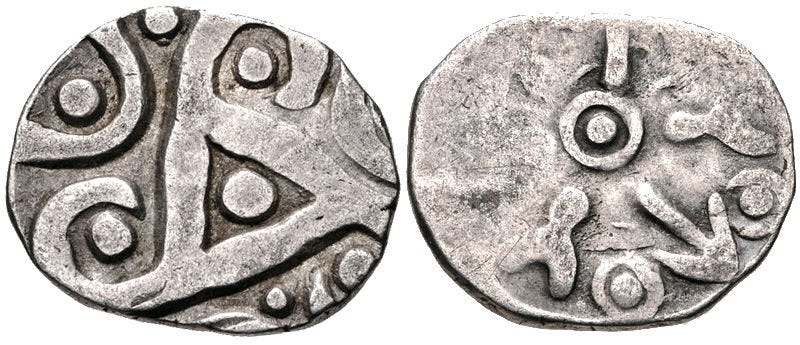
The coins are mainly square or rectangular, though they can be round. They are mostly made of silver, usually high purity. And there are marks all over them, some larger and many only a couple of milimetres across. They don’t always cluster together and aren’t necessarily arranged in an orderly fashion on the coins either. The number of them can also vary from 2-3 to more than 30. They are usually simple designs. The most complicated are shapes like elephants or abstract human shapes but most are much more geometric, like crosses or clusters of circles.
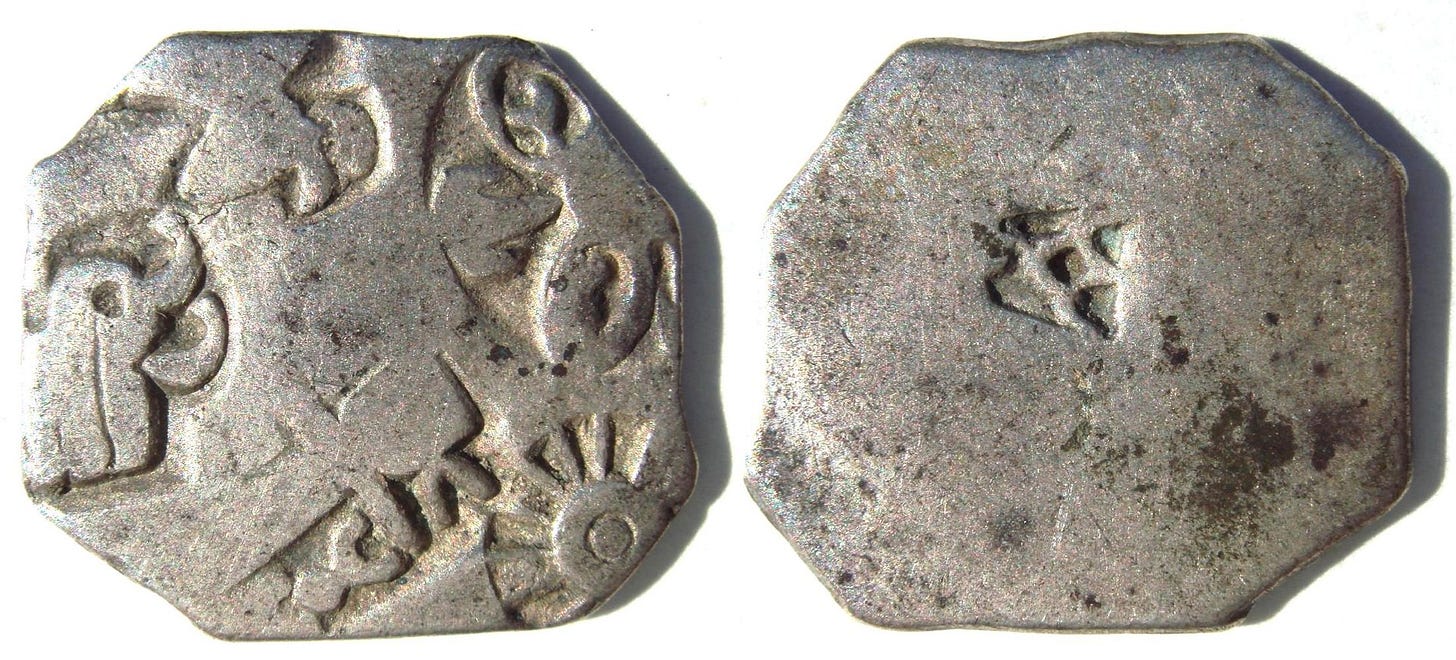
One theory is that these marks (which are usually called punches or punchmarks, because they would have been carved into a small chisel-like object then hammered into the coin) were made by several different people over the life of a coin: each person who used it, or perhaps only specific people, such as money changers, might have had their own stamp and would have confirmed that the metal was the right weight and purity. Another theory is that state authorities put specific clusters of punches on each coin, which might then have been added to by other people.
There are hundreds of different series of these coins, which share features like weight, combinations of punches and rough region where they are mostly found. So the chances are that some of these series worked in one way and others worked in slightly different ways but it looks as if the logic of these coinages was all roughly the same and it looks as if some element of ‘crowd sourcing’ was part of it: rather than there being one source of value - the state or the natural value of a metal (with the state guaranteeing its purity) - these coins seem to have relied on the combined punches of different authorities or people.
Still, they solved the same issues: punchmark coins could be used to do business anonymously, to take taxes or pay soldiers without debt or credit arrangements that people might not trust themselves or others long enough to deliver on. And this was all a sign of another group of societies, like the ones in East Asia and in West Asia, that were going through a similar set of transformations - more people becoming interdependent in increasingly complicated ways and looking for new ways of being able to start and finish a transaction in one moment, using something everybody could agree the value of.
Inventing invention
The question of when money was invented, or by whom, is one that people have come up with lots of answers to. Once upon a time, it was said to be the ancient Greeks, because Plato was one of the first people to write about it. Then there were debates (at times heated) about whether China started earlier. South Asian coinage got wrapped up in legends, pushing its date way back, millennia into antiquity, until archaeological evidence became irrefutable that it, too, came from the same cluster of centuries in which it is futile to say exactly who ‘got there first’.
Apart from anything, none of the people in these societies likely had very much contact with one another. A few people may have moved between them, but not enough to share a new discovery like coinage. And the fact that each of the three traditions is slightly different, despite tackling the same problems, just goes to show that these were parallel developments.
Many centuries later, in the era of industrial capitalism, from the 18th century onwards, it became crucially important to find ways to prove or document who was the first person to have an idea or make a new tool. In a new world of comparatively easy information sharing, via print media, and factory owners able to invest huge amounts of money in a new idea, ‘invention’ was invented as a moment of inspiration, usually by an individual, followed by a big change, spreading outwards from that one spark, right across the world.
As the development of coinage shows, though, this idea of ‘invention’ was another way of responding to new problems, in this case, how to attribute fian cial benefits to somebody as ideas became an industrial commodity. Before that, people were just as inventive but nobody went looking for patents or prize winners. Ideas stuck or faded because they did, or didn’t, solve problems that people had, and people in distant places might have similar, but not identical, ideas to tackle the same issues.




